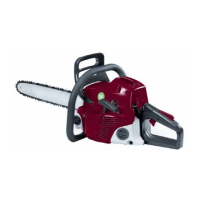
Do you have a question about the EMAK GS35 and is the answer not in the manual?
Comprehensive kit for service and maintenance tasks, including specialized tools.
Device to measure engine compression, essential for diagnosing performance issues.
Tool for measuring engine speed (RPM) for 2- and 4-stroke engines.
Apply compression tester on cylinder and verify compression value (7.5 bar / 110 psi).
Inspect cylinder for scoring and piston for wear using feeler gauge for piston ring gap.
Properly assemble cylinder and piston, noting arrow direction and tightening torque.
Dismount cylinder cover and clean fins, starter case, and flywheel with compressed air.
Check catalytic or non-catalytic muffler for dirt, oil, blockages, or damage.
Verify fuel quality and inspect/replace fuel filter and sintered internal filter.
Test fuel line for leakage or unstable pressure using a pressure gauge.
Check breather components and verify valve function using a pressure gauge.
Seal ports and test for pressure loss to check for leaks in the engine seals.
Inspect manifolds for rubber deterioration, hardening, cuts, or holes.
Inspect starter housing components for wear and perform cleaning or replacement.
Check the gap between spark plug electrodes, ensuring it is within the 0.5-0.7 mm range.
Use a tester to verify ignition current by pulling the starter rope.
Adjust the air gap between the flywheel and coil using a 0.3 mm shim.
Inspect the flywheel key way for condition and position, adjust or replace as needed.
Clean oil tank breather with compressed air and verify bar/chain oil quality.
Periodically check sprocket/power mate ring wear; replace every 100 hours.
Check brake band, plate, and rubber for wear; replace if wear limit is below 0.6 mm.
Inspect oil pump, worm gear, hose, and filter; use piston stop and specific tools.
Inspect worm gear for wear/damage and replace using the correct tool and fitting process.
Replace shock absorber components if they show signs of wear or breakage.
Lubricate sprocket nose, clean rail/holes, check bar parallelism, and turn bar for wear.
Clean sponge or cloth air filters with specified methods; replace when damaged.
Check needle valve position with a caliper and adjust for proper fuel delivery.
Clean carburetor components, use repair kit for worn parts, or replace if oxidized.
Utilize a special screwdriver for precise adjustment of the carburetor's 'L' and 'H' jets.
Detailed steps for adjusting idle (L jet) and maximum (H jet) settings for EURO standards.